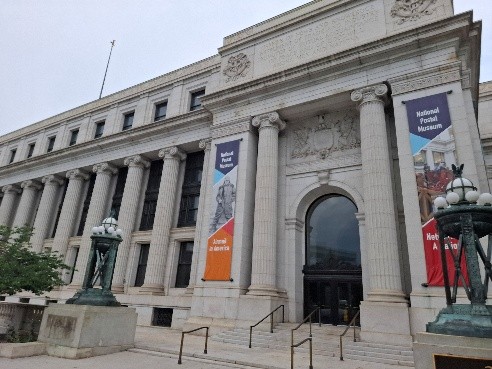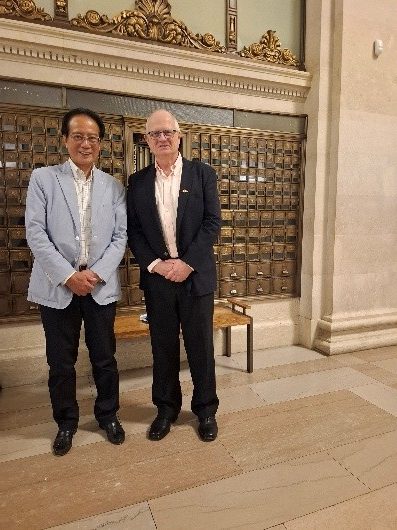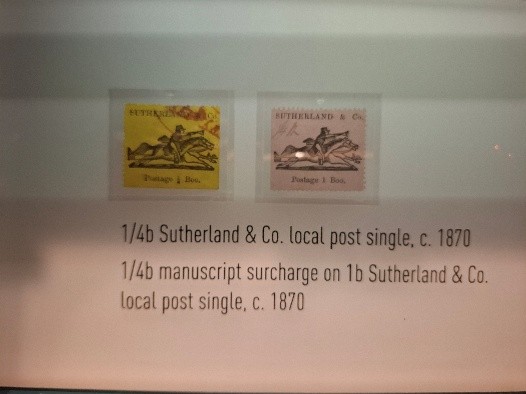2025年6月5日に羽田を出発し、NY.経由でワシントンD.C.のスミソニアン国立郵政博物館に向かう旅に出かけました。翌6月6日、ワシントンD.C.のスミソニアン郵政博物館を訪問し、その巨大さと収蔵量に驚愕しました。事前に周到に根回ししてくれた現地コーディネーターの計らいで、まず、副館長のメンスフォース氏と面会しました。
1時間半にわたる面会で、2022年に設立した一般財団法人「日本郵便切手デジタル博物館」の所蔵する日本切手5000種とその全てを和英文解説した資料2000枚及び10年前に著した著書『日本郵便切手と近現代史抄』を寄付したい旨、要請しました。メンスフォース副館長に、切手と資料等の寄付目的は、年間1000万人以上の来場者を誇る世界最大の博物館群に日本切手と資料を寄付する事で、世界の人々に日本の近現代史や伝統文化、そして、美しい自然などを深く知ってほしい、切手や郵便資料はそのソフトパワーである事を切に訴えました。メンスフォース氏はとても好意的に私の話を聞いて下さり、翌日に館長と主席学芸員との面会を約束して下さいました。
翌6月7日、同博物館のグルーバー館長と、折しも近くで開催されていた「世界郵政博覧会」会場で面会しました。彼は親日家で、私の寄付資料を見て、1871年(明治4年)の日本郵便創始の真実や、日本近現代史に郵便の果たした役割などについての説明をとても丁寧に聞いてくださり、最後に一緒に写真を撮って下さいました。その後に、主席学芸員のピアッザ氏と面会し、持参した日本初期の手彫切手や希少切手を見てもらい、彼からは、1871~2003までの総合的な全切手コレクションと解説資料のオリジナリティーに高評価を頂きました。ただし、その時に当該博物館が巨大組織で、寄付受付の検討に時間がかかることを伺いました。
帰国後、6月25日、スミソニアン郵政博物館Librarian (司書)バッシルワイルダー氏からの公式レターが届きました。その内容は、まず、「貴方の著した『日本の郵便切手と近現代史抄』を、スミソニアン郵政博物館の蔵書にした」ことが記載されていました。但し、本体の切手と郵便資料の事は別の検討事項であり、今後の審査事項である事が解りました。これには相当な時間がかかりそうです。
しかし、何はともあれ、日本人が著した、日本の切手を通しての近現代史資料(著書)が、スミソニアン郵政博物館に評価され、その名が公式に残されたことは私にとって大きな栄誉となりました。これから、私の財団が申し出た日本切手と資料寄付に関しては、スミソニアン博物館内部の各委員会の検証や審議などにかなりの時間がかかることが予想されますが、寄付が叶っても叶わなくても、スミソニアン郵政博物館のトップ達に日本の近現代史や郵便事業の果たしてきた功績を、全切手と資料と共に伝えられたことは、大きな意義があったものと自負しています。

スミソニアン郵政博物館 外観

メンスフォース副館長と

貴重なサザーランド切手

グルーバー館長と
——————————–
On June 5, 2025, I departed from Haneda Airport, traveling via New York to begin my journey to the Smithsonian National Postal Museum in Washington, D.C. The following day, June 6, I visited the museum and was overwhelmed by its immense scale and vast collections. Thanks to the thorough arrangements made in advance by my local coordinator, my visit began with a meeting with Deputy Director Daniel Mensforth.
During our hour-and-a-half conversation, I expressed my wish to donate 5,000 Japanese stamps—along with 2,000 bilingual explanatory documents—and my book, Japanese Postage Stamps and Modern History (published 10 years ago), from the collection of the Japan Postal Stamp Digital Museum, which I founded in 2022. I explained to Mr. Mensforth that my purpose in making this donation was to allow the world’s largest museum complex, which attracts over 10 million visitors annually, to share Japan’s modern history, traditional culture, and natural beauty with people around the globe. I emphasized that stamps and postal materials are a form of “soft power” that can communicate these aspects in a unique way. He listened to my proposal with great interest and kindly promised to arrange a meeting the following day with the museum’s Director and Chief Curator.
On June 7, I met with Director Elliot Gruber at the venue of the “World Postal Exhibition,” which was being held nearby. A known admirer of Japan, he carefully examined my donation materials and listened attentively to my explanations about the origins of Japan’s postal system in 1871 (Meiji 4) and the role the postal service has played in the nation’s modern history. Before we parted, he graciously took a commemorative photo with me.
Later that day, I met with Chief Curator Daniel Piazza, who examined the early hand-engraved Japanese stamps and rare issues I had brought with me. He spoke highly of the originality of the comprehensive collection and accompanying explanatory documents covering the years 1871 to 2003. However, he also explained that, because the Smithsonian is such a large organization, the process of reviewing and approving donations takes considerable time.
After returning to Japan, on June 25, I received an official letter from Basil Wilder, Librarian at the Smithsonian National Postal Museum. It stated that my book, Japanese Postage Stamps and Modern History, had been accepted into the museum’s permanent collection. However, the stamps and postal materials themselves would be subject to a separate review process, which could take quite some time.
Nevertheless, the fact that a work authored by a Japanese citizen—presenting modern Japanese history through its postage stamps—was recognized and formally preserved in the Smithsonian’s National Postal Museum is a great honor for me. While the donation of the stamps and related materials will require further review by various internal committees and may or may not ultimately be accepted, I take pride in having had the opportunity to present Japan’s modern history and the achievements of its postal system, together with the complete stamp collection and explanatory documents, to the museum’s leadership.


